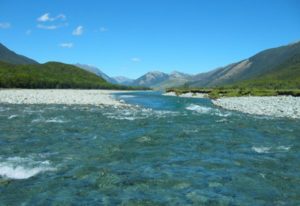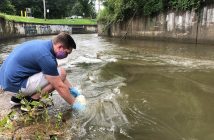The Ministry for the Environment and Statistics New Zealand’s latest national report makes very dismal reading
Our fresh water 2017 measures the quality of New Zealand’s waterways, including water quality, biodiversity and cultural health.
Nitrogen levels at over half of monitored river sites are getting worse, according to the report, and 72 per cent of the 29 native fish species monitored are either threatened with or at risk of extinction.
The data compiled in the MfE report conclusively confirms that the overall quality of the freshwater environment is declining rapidly, University of Canterbury, Director, Waterways Centre for Freshwater Management Professor Jenny Webster-Brown says.
“This is consistent with all recent reports and research on our freshwater systems … there is little evidence to the contrary,” she observes.
“In the last 10 years we have begun to address the problem through policy changes and law amendments, but a greater investment of time, funding and effort is needed in action and innovation before we will be able to halt and, if possible, reverse this trend.
Consistent, rigorous monitoring data is vital to understand the freshwater environment’s response to pressure but, on its own, will simply continue to chart the decline of water quality, quantity and ecosystem health.
The report highlights the ongoing and escalating problem of nitrogen leaching from land into the waterways, Webster-Brown notes.
“This compares with apparently improved control of phosphorous, from the same source, likely due to more fencing and planting of riparian strips on agricultural streams.”
She concedes that nitrogen control is a “more difficult” problem to solve, particularly with the legacy of high nitrate in groundwater in agricultural regions of New Zealand, but this should act as an even greater incentive to find/fund solutions and ways to manage high nitrate concentrations (for example, in drinking water) in the meantime.
“The report also highlights the poor state of urban streams, something which is easily overlooked in the rush to blame dairy farmers for all of our freshwater problems.
“There are already solutions available for preventing contamination of urban streams, a problem shared by all cities, and yet we still cling to the same systems of stormwater control and choice of problematic building materials that have led to these issues …. and over-use urban water supplies that would otherwise recharge these systems.”
Remove obstacles
Webster-Brown says obstacles to uptake of sustainable urban water technologies need to be identified and removed.
“So, by all means, collect more data to address the data gaps identified in the report … this is essential.
“However, it is vital that we also invest in, and otherwise provide incentives for, actions that will protect our freshwaters and change this scenario for the better.”
Human activities have affected groundwater quality at about 40 per cent of long-term monitoring sites across New Zealand, GNS Science Division Director – Environment and Materials Dr Chris Daughney adds.
“At these sites, the main sign of human impact is in the form of nitrate concentrations that are above the natural baseline (i.e. the concentrations that are expected in the absence of human impact).
“At many of these sites the observed nitrate concentrations are not far above the natural baseline, but at some sites (about 5 per cent of the total number of long-term monitoring sites), the nitrate concentrations are much higher than baseline and can even exceed the drinking water standard.
GNS Science used its in-house expertise to evaluate the age of the groundwater and found that for groundwaters that were recharged prior to about 1880 the nitrate concentrations tend to be low and at baseline levels.
However, the nitrate concentrations increased slightly in some parts of the country for groundwaters that were recharged from about 1880 to about 1955, while the nitrate concentrations in some monitoring sites have exceeded baseline by a significant margin in groundwaters recharged since about 1955.
“Through this work, we have inferred that the increase in nitrate concentration from baseline to slight elevation around 1880 corresponds with the start of the meat export industry in New Zealand, whereas the transition to even higher nitrate concentrations at some sites after 1955 corresponds with the onset of industrialised agriculture.”
Ultimately, improving understanding of water resources in terms of quality and volume requires more monitoring and scientific investigation.
“The fact is that groundwater resources are very important for New Zealand, but they remain poorly understood,” Daughney believes.
For example, he explains that 3D geological models of aquifer systems are important for groundwater management to identify how much groundwater is likely to exist in the aquifer, where the groundwater is found and what flow paths it might take through the aquifer.
“So far, we only have such 3D geological models for about 30 per cent of New Zealand’s aquifers,” Daughney notes. “And that’s just one type of information we need to more effectively understand our groundwater system.”
Agricultural avoidance
Meanwhile Massey University Freshwater Ecologist Dr Mike Joy believes Our fresh water 2017 features some “really obvious” attempts shift focus away from agricultural impacts.
“Once again waterways in urban catchments are given the same prominence as pastoral even though urban make up less than 1 per cent of river length and pastoral are 40 per cent.”
He analysed some of the key findings to demonstrate some of the biases, observing that when it comes to nitrogen levels the report says 55 per cent of sites are getting worse and 28 per cent getting better.
“But that’s for all sites,” Joy notes. “If, as would be logical, you look at landcover classes separately, looking at pasture sites showed 72 per cent got worse and 28 per cent better.”
Phosphorus is a “non-issue” because the algae can in most cases get all the phosphorus they need to cause problems from the sediment where levels are high, so don’t need it from water which is where it is measured.
“For E. coli, the report inexplicably switches from the 20-year record for other parameters to 10 years, and as would be expected after removing most of the data then 52 per cent of sites have no trend because of this lack of data.”
However, 60 per cent of pasture catchments got worse and 40 per cent better – for urban one site got worse. “This sounds a bit different to the 22 times higher in urban and 9.5 in urban reported.”
A number of similar issues arise in the detail of the main report, Joy argues, apparently from “a lack” of freshwater ecological knowledge.
He cites the section on nitrogen, which features figures that used the banding from the National Policy Statement.
This approach is flawed for two reasons, he maintains. “As far as I’m aware the limits are still subject to public submissions so could and should be changed, and nitrate toxicity is a red-herring because we know that fish or invertebrates cannot die twice.”
Joy says “much lower levels” of nitrate are well known to have algal blooms that cause fish deaths through oxygen depletion, so the amount of nitrogen that is toxic to them is a non-issue and only occurs in laboratory experiments and not real-life.
“The ANZECC guideline level is around 0.5 mg/l about one tenth of the toxic limit, thus using these toxic limits is disingenuous.”
Similarly, he says the section on algal blooms starts with the statement that 83 per cent of the length of rivers is not expected to have prolonged algal blooms.
“This statement misses the point because just one day of a bloom is just as lethal to fish and other life as any longer length of time – once again they can’t die more than once.”




